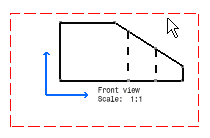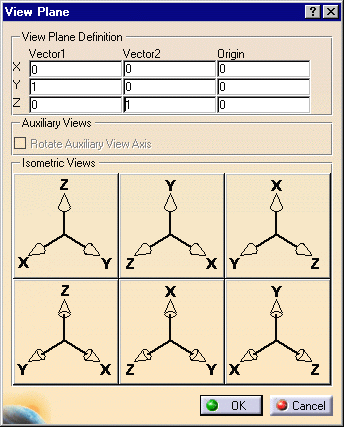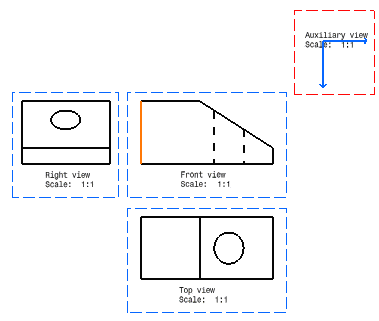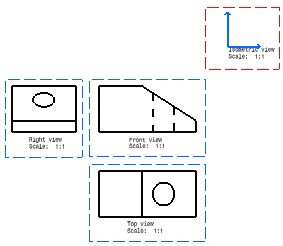Defining the View Plane
| This task will show you how to
define the plane of a view (a front view, an isometric view
or an auxiliary view).
Any created view lies on a 3D plane. In other words, a view lies on some kind of a 3D plane whose definition can be accessed using the Plane Definition dialog box. The view plane can be defined and if needed, modified in this dialog box. The view plane will be defined in accordance with two vectors and an origin point. This view plane definition functionality will be used, via the Plane Definition dialog box for acknowledging the 3D relationship between views. This will be the case when creating a multiple view projection or when creating views using folding lines.
|
||||||||
| Define the front view plane: | ||||||||
| Open the IntDrafting_Viewplane_Front.CATDrawing
document.
Activate the view in which you want to change the plane definition, by double-clicking on this view.
|
||||||||
| 1. Click
the View Plane Definition icon from the Multi View toolbar (not displayed by default). OR |
|
|||||||
| 1. Select
the Tools -> Multi View -> View Plane Definition command
from the menu bar.
The View Plane Definition dialog box appears with options on the view plane definitions for front views, auxiliary views and isometric views.
|
||||||||
| 2. Select
the desired options from the
View Plane Definition dialog box. In this
case, enter 1 as the Y value for Vector1 and 1
as the Z value for Vector2.
3. Press OK.
|
||||||||
| Define the auxiliary view plane: | ||||||||
| Open the IntDrafting_Viewplane.CATDrawing
document.
For creating an auxiliary view, you need to create any view first and then modify the view planeyou want. In this case, we created an auxiliary view. Activate the view in which you want to change the plane definition, by double-clicking on this view.
|
||||||||
| 1. Click
the View Plane Definition icon
from the Multi View toolbar (not displayed by default). OR |
|
|||||||
| 1. Select
the Tools -> Multi View -> View Plane Definition command
from the menu bar.
The View Plane Definition dialog box appears. |
||||||||

2. Click in another orthogonal view one line that will be used to define the auxiliary view plane.
The Plane Definition dialog box automatically displays the corresponding vectors and origin point. The Rotate Auxiliary View Axis option is activate, by default.
3. Press OK. The axis automatically rotates in accordance with the dialog box values applied to the selected plane.
|
||||||||
| Define the isometric view plane: | ||||||||
| Open the IntDrafting_Viewplane_Isom.CATDrawing
document.
|
||||||||
| 1. Click the New View icon Make sure the view in which you want to change the plane definition is active. For this, double-click on this isometric view.
|
||||||||
| 2. Click
the View Plane Definition icon
from the Multi View toolbar (not displayed by default). OR |
|
|||||||
| 2. Select
the Tools -> Multi View -> View Plane Definition command
from the menu bar.
The Plane Definition dialog box appears.
|
||||||||
| 3. Enter
the desired options from the dialog box (Isometric).
OR 3. Select the desired pre-defined isometric view vectors. In this case, select YZX.
4. Press OK.
|
||||||||
|
||||||||








